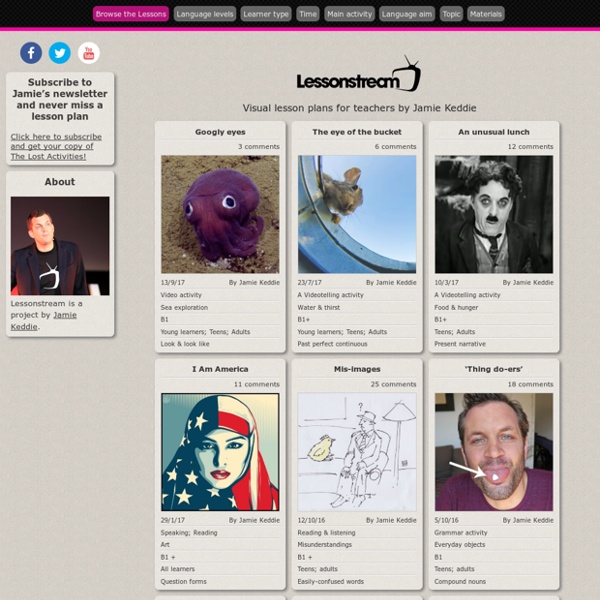



http://lessonstream.org/lessons/
Related: eikaiwaLanguage Teacher Toolkit: 5 great zero preparation lesson ideas When the pressure is on and there are only so many hours on the week, you need a repertoire of zero preparation go-to activities which promote input and/or practice. Here are five you might well find useful. 1. My weekend We know that listening is the most important yet often neglected skill for language learning. Downloadable lesson materials 36 Questions to fall in love Level B1 upwards Skills: speaking and listening Language: Question forms (including slightly more complex B1 forms) elt-resourceful-36-questions-to-fall-in-love A free downloadable lesson, particularly suitable for Valentine’s Day, but usable at any time of the year, about 36 questions which might make you fall in love.
What’s the Best Tool for the Task? Included in the Digital Tips Advent Calendar and part of the Effective Technology Integration category “Technology is just a tool. In terms of getting the kids working together and motivating them, the teacher is the most important.” – Bill Gates
Jing, Record and share videos on your computer, by TechSmith The always-ready program that allows you to instantly capture images and record video on your computer—then share them with anyone. Jing is a great tool for adding basic visual elements to all of your online conversations Jing for Screenshots Capture What You See Ask Answer Add - A Speaking Activity to Help Learners Maintain a Natural Conversation Ask Answer Add - A Speaking Activity to Help Learners Maintain a Natural Conversation Ask Answer Add is one of my favorite speaking activities and requires no resources in class. It is a very straightforward exercise and I’m sure it will really help your learners build their speaking skills and learn the invaluable skill of maintaining a conversation. The premise is quite simple, and it is suitable for any level of learner. In fact, I have been using this with a group of lower level non-English majors and with different class of higher level English majors and I have had equal success in both classes. Ask The idea behind the activity is very simple.
Elementary topical news lessons Monthly topical news lessons at elementary level with worksheets for you to use in class. Each worksheet contains vocabulary, speaking and grammar work as well as reading practice. Elementary news lesson: Is it safe to eat eggs? Teaching with video By Jamie Keddie Have you had some interesting experiences when attempting to integrate video into your lessons? Jamie Keddie answers a question on how to get the most out of film-related resources. My name is Elena and I'm from Russia. 10 ways to use screen capture technology In this blog post Russell Stannard looks at the uses of screen capture technology. Russell is the founder of www.teachertrainingvideos.com. He was awarded the British Council ELTons award for technology and the Times Higher Outstanding Initiative award. Russell lectures part-time at the University of Warwick and is also a NILE associate trainer. He trains teachers in using technology, working all over the world.
Most Influential Images – elt sparks “Pictures can create an atmosphere where change is possible.” – James Nachtwey The 100 most influential photos published in a website by time magazine is the perfect SPARK to talk about the power of images. Striking and powerful images engage students towards deeper discussion where they not only describe the image, but also speculate on the stories behind them. Lesson Plans Archives - Lesson Plans Digger In this post, I am sharing an activity which helps students deal better with the Reading and use of English part 6 (cross-text multiple matching) activity in Cambridge Advanced exam. Continue Reading … This is a lesson I have recently tried with my C1 teenage group. It is based around the climate change solutions quiz by CNN. The activities include vocabulary brainstorming, mini group discussion and ranking, and a possible writing extension. You will need around 90 minutes for this class.
Tech Integration for YLs “Put it before them briefly so they will read it, clearly so they will appreciate it, picturesquely so they will remember it and, above all, accurately so they will be guided by its light.” —Joseph Pulitzer Transform your young language learners into classroom reporters. Our students can learn by reading current events and news articles. They can also act as journalists who write short news articles. This helps them enhance their reading and writing skills, because they will need to conduct research and summarize local news.
20 WebCam Activities for EFL ESL Students Back in November 2008 I published Part 1 of a series of articles intended to explore the use of WebCams in education. I have now finally got round to writing Part 2 which is a collection of 20 activities EFL ESL teachers can do with their students. Here are some links to useful free video communication tools that you could use for these activities.MailVu is a simple to use app which runs in the browser and enables students to record a short message which can be sent by email.EyeJot is another simple video email app which also has a mobile version.Skype is of course the mainstream choice for synchronous communication.Oovoo is a Skype competitor which also enables the recording of video interviews by capturing both interviewer and interviewee. 20 WebCam Activities 1.